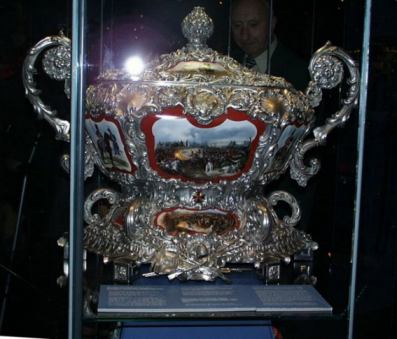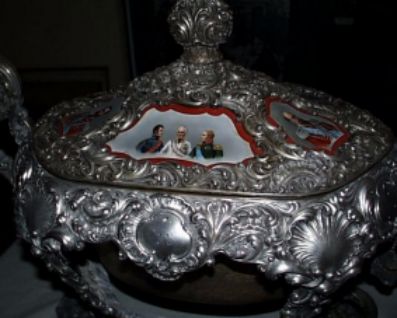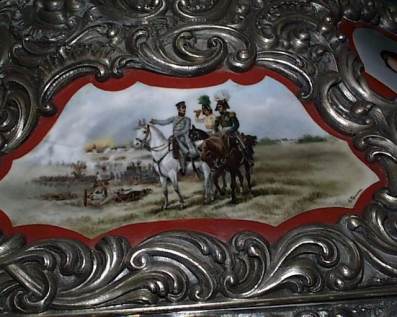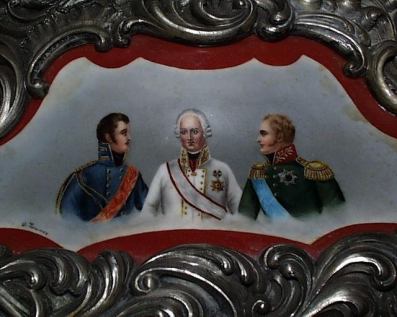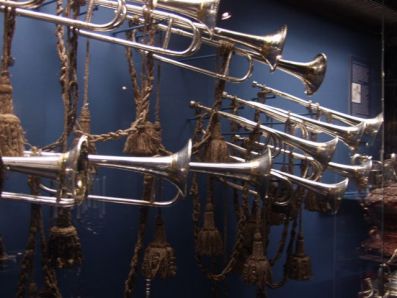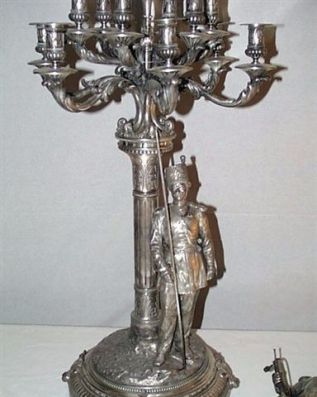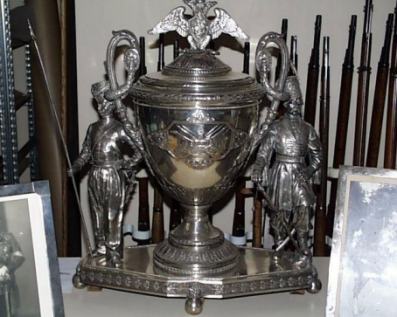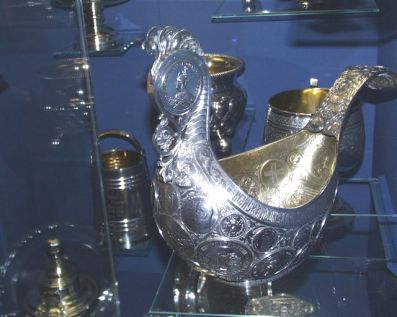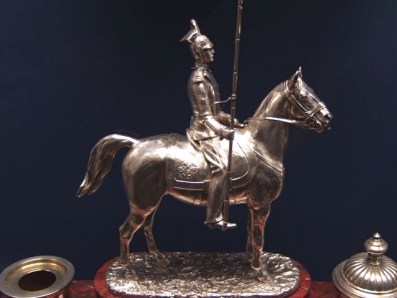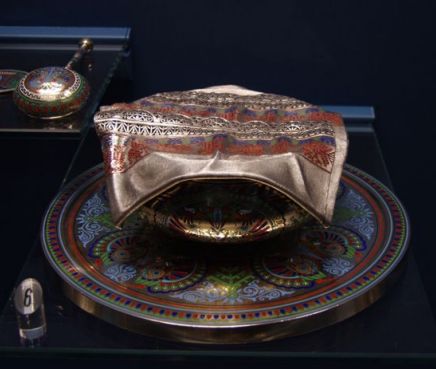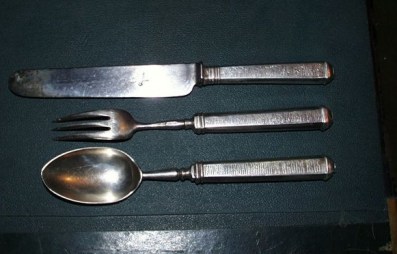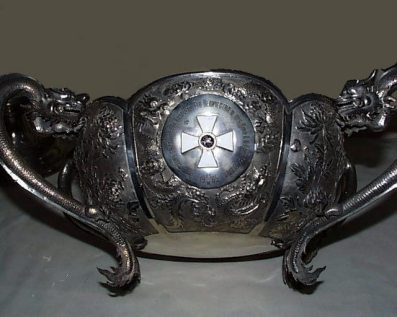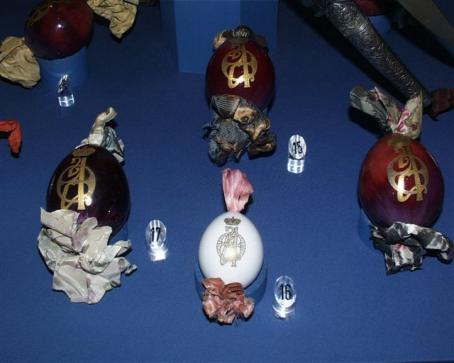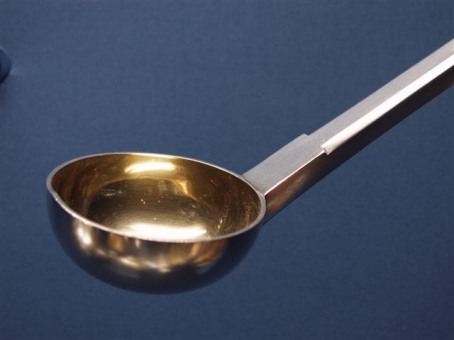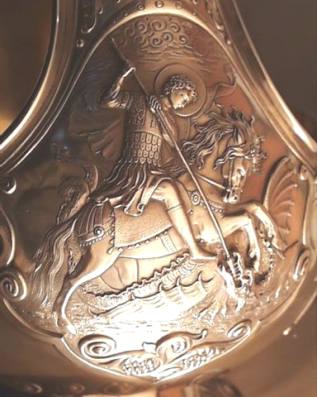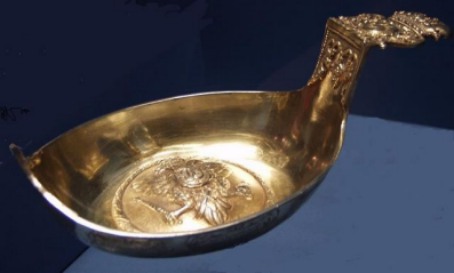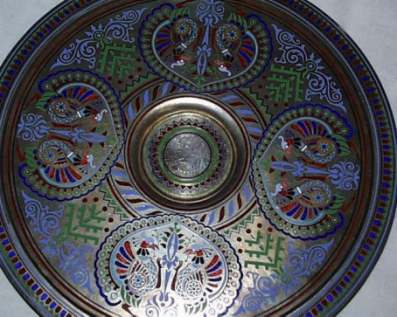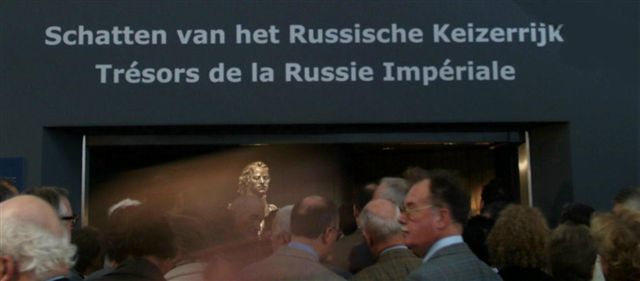by Claude-Charles Feÿs, photos by Raoul Verbist
The hall of Imperial Russian Silverware of the Musée Royal de
l'Armée et d'Histoire Militaire of Bruxelles
(part 2)
Description and photos of some pieces
Descriptions obtained by documentation supplied by members and
historians of the Museum, the SRAMA and guided visits to the Hall.
(photos taken in the Museum 'stage room'; in the Museum 'cabinets' and
at Courbevoie - Paris in the headquarter of the Amicale des Cosaques de
la Garde - Guard Cossaks Association)
Photos copyright Raoul Verbist, ASCAS and SRAMA member.
The outstanding silver-gilt punch bowl at the time of its
restoration.
Details of the punch bowl with the three winners of the battle of
Leipzig against the French Emperor Napoléon, in 1813:
the Tsar Nicholas I, the Austrian Emperor and the King of Prussia
This punch (or soup) bowl weighing over 110 pounds and made by
Ovchinnikov, one of the most famous Imperial Russia silversmiths, is a
unique piece made by the method of lost wax casting. Its overloaded
Rococo form, inspired to Louis XIV and Louis XV style, contrasts with
the simplest shape of Art Nouveu pieces made in Russia at the beginning
of 20th century.
This bowl is decorated with paintings on porcelain of the last Romanov
Dynasty Tsars in military uniforms and scenes of the 1813 Battle of
Leipzig with the glorious Cossacks charge. The bowl has a gilded
removable liner on the inside. It was originally in the Cossak Guard
officers' mess of St. Petersburg and was designed and created by
silversmith Ovchinnikov to celebrate the centennial of this battle
against Napoleon.
The back of the bowl is inscribed with the names of the Cossaks Regiment
Commanders and the date of their appointment. On the front of the bowl
there's the Cross of the Knights of Malta Order, exibited also on the
Regiment's flag (Tsar Paul I was the 72nd Grand Master). The Malta Cross
was added to the Regiment's banner on September 14, 1911. The base is
decorated with trophies of weapons, trumpets and military hats.
The bowl has Ovchinnikov hallmarks on the body and on the lid.
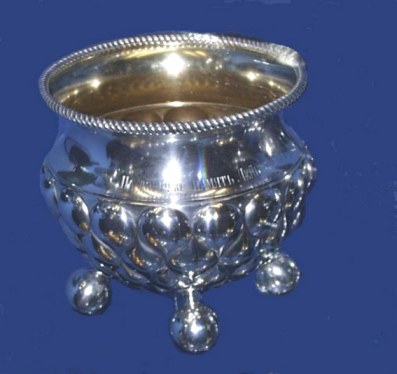 |
The wide silver-gilt Fabergé bowl
This silver bowl is not representative of the Fabergé style, usually
distinguished by well balanced small artifacts realized with the use of
various silversmithing techniques. This is a heavy, serial production,
machine-made, and hand-finished piece, engraved on request with a
particular dedication. On the other hand, Fabergé firm employing several
thousands of craftsmen in its workshops, had a production of ordinary
artifacts: dishes, silverware, bowls, etc.... and only selected masters
were devoted to the production of high level artworks such as enamelled
eggs, frames, snuff and powder boxes, figurines, jewels, cases, etc....
The silver gilt trumpets
The 22 silver trumpets were made by Romo, a musical instrument
maker.
It is a common practice to use the outstanding sonorous tone of silver
and silver-plate to make trumpets or flutes. Less usual are decorations,
engravings and gildings to mean that these are 'honor trumpets'. These
trumpets have their original cords and flocks and a device to modify the
octaves. This is proof that in 1913, the centennial of the Battle of
Leipzig, they were made not only for decorative purposes but also to
play music such as the Mendelssohn's Wedding March, that is the Guard
Cossack Regiment's March. Every octave has a corresponding number on a
trumpet.
The trumpets are of three types and dimensions constituting a really
particular orchestra. All the pieces have 84 zolotnicki (875/1000 purity
degree) hallmarks and the maker's mark Romo.
The candlesticks
These tall and heavy candlesticks made by Ovchinnikov represent a
Cossak in the uniform of the period of Catherine II. It is intesting to
note that the Cossack's figure of these clandlesticks has the same form
of other objects of the collection, so that it's likely that Ovchinnikov
used a single mould for a large set of military inspiration items.
All candlesticks have their detachable candle holders.
The silver gilt centerpiece cup with cover
This silver gilt centerpiece has a double-headed eagle cover and two
Cossacks, one of which is a lancer, standing at each side. It was made
by silversmith Ovchinnikov and offered by the officers of the Cossack's
Guard Atamansky Regiment to the St. Petersburg Guards Officers' mess for
the centennial of the Battle of Leipzig in 1913. The centerpiece has the
84 zolotnicki hallmark.
The silver gilt kovsh
The kovsh is a drinking vessel with a side handle evoking the aspect
of a ladle or a spoon. The kovsh, carved in wood until the XIV century,
was used as an honorific gift with sculptures, decorations and
inscriptions. Usually the side opposite to the handle is finished with a
double-headed eagle plaque. The most precious kovshs are made in gold or
gilt silver. This kovsh is decorated with classical Russian medals, such
as that commemorating the 300 years of Romanov dynasty or that
commemorating the war against the Turks.
The kovsh is a gift received by the St. Petersburg Guards Cossacks'
mess.
The Lancer inkstand
This silver piece represents a mounted horse Lancer on a marble base
holding the lance with the Regiment's banner. The inkstand is in 84
zolotnicki silver and was offered in 1911 to General de Sporé by Lancer
Empress Regiment officers. It is lacking one lid.
The silver gilt bowl with fabric imitating 'champlevé' lid
This is the masterpiece of this collection, inspired by Byzantine
taste and made in 91 zolotnicki silver (947,92/1000), a comparatively
high degree for silver of Russian manufacture. The bowl has Ovchinnikov
hallmarks dating to 1874 and its cover, imitating cross-stitch point, is
fully hand-made, with soldered silver wires forming pretty motifs
intertwined with 'champlevé' parts. The bowl itself attains the highest
level of Russian silversmithing, reminding one of the best Aztec
jewelry. The 'champlevé' silver was typical of Russia and the best
specialists were at Veliky Ustyug. Champlevé technique consists of
applying enamel of different colors on to an engraved object and
reheating the object in the oven without melting the silver. The
cloisonné is another Russian technique done by soldering silver wires
according a prefixed drawing and filling the cells with powder of enamel
before reheating in the oven.
Silverware of the Cossack Regiment mess
(these silverware are Cossack Officers and White Russians sons and
grandsons souvenirs preserved at Courbevoie - Paris)
The silver centerpiece dated 1905
This beautiful 84 zolotniki silver centerpiece is decorated with the
4th Class Cross St. George Order, the most popular Russian Order. It is
an Emperor's gift to Cossack Guards' mess decorated with dragons as a
souvenir of Russian-Japanese war of 1904, .
The porcelain eggs
Among the pieces of the Museum collection there is a group of
porcelain eggs. The gift of Easter eggs was a Russian tradition like the
famous Carl Fabergé eggs offered at Easter by Tsar Nicholas II to his
wife, the Empress Alexandra Feodorovna. The Fabergé, (formerly
Fabriguer) belonged to a French Huguenot family which emigrated to
Imperial Russia when Louis XV revoked the Edict of Nantes declaring
Protestantism illegal. All Imperial eggs are well known and indexed and
are now kept by several European Royal Families, Russian Museums and the
Forbes private collection in the USA, recently bought by a rich Russian
collector. Our good wish is that, returning in their country, the eggs
may be presented to the Hermitage or Tsarskoïé Tsélo Museums ! The
Easter eggs of the Cossacks' collection were given each year by the
Empress Alexandra Feodorovna to the officers of the Cossack Regiments of
which she was colonel. They are decorated with the initials AF
(Alexandra Feodorovna) in old Russian characters except one with the
initials of Nicholas II, and still have their decorative ribbons.
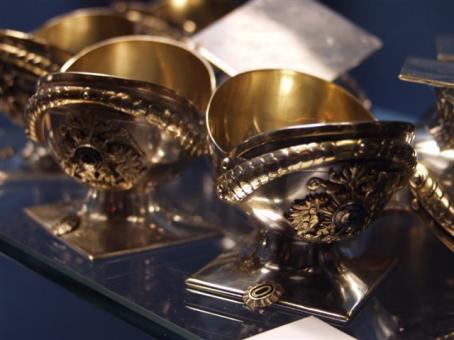 |
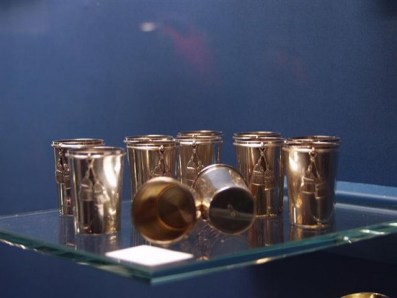 |
The vodka tumblers
The Museum also has a series of richly decorated vodka tumblers
imitating the Cossacks and Lancers military hats. The most beautiful
one, unfortunately in unmarked silver, is a red gilt mitre reminding one
of Fabergé production for its high level of manufacture. Obviously these
artifacts were not thrown over the left shoulder after having been
emptied, as this custom wasn't practiced by Russian high society.
The silver gilt punch ladles
These punch ladles are very very beautiful. Especially note the
essential style and shape anticipating Art Deco.
Silver gilt kovsh detail
St George and the dragon
Silver gilt kovsh
>Champlevé silver tray
The small clock
This artwork has the hallmarks of St. Petersburg master silversmith
Sergeï Verkovtsev (assayer D.Ch) and was a gift to a General by his
Officers and soldiers. The clock was restored by the students of the
Fine Arts Antwerp Academy.
The crystal fruit bowls
These bowls were made by Ovchinnikov and are decorated with 84
zolotniki molded silver Cossacks with uniforms of the time of Catherine
II.
Photos copyright Raoul Verbist
This is the English version from the original French text,
translated by Giorgio Busetto and revised by Jayne Dye
|
|
